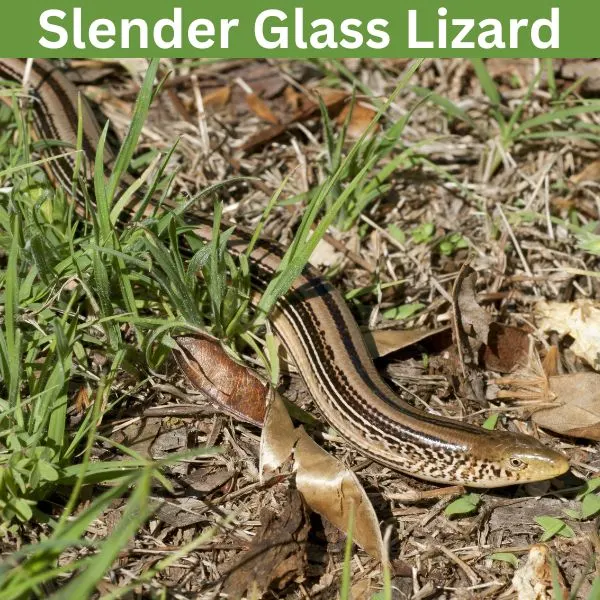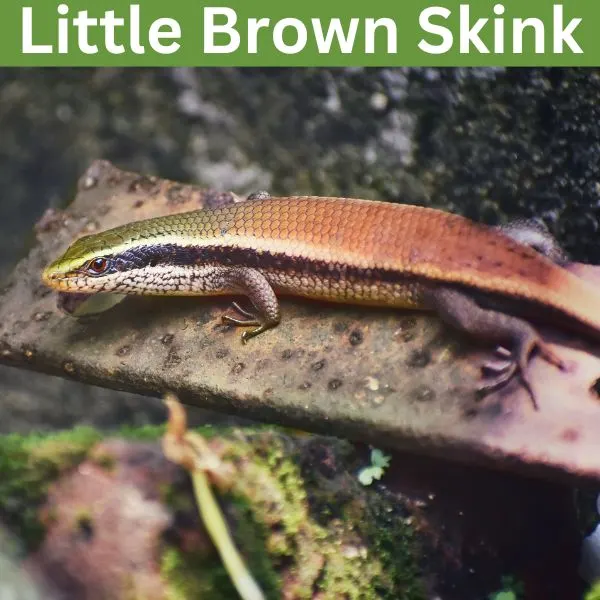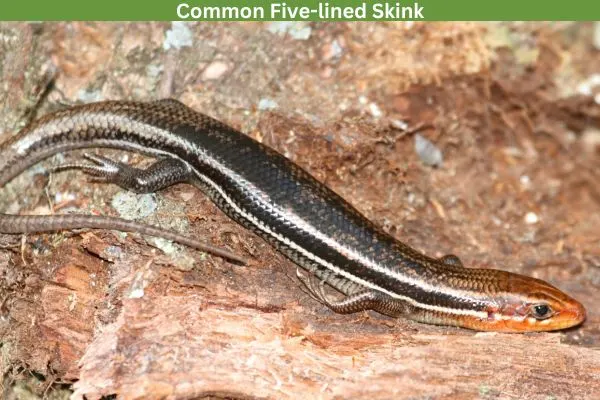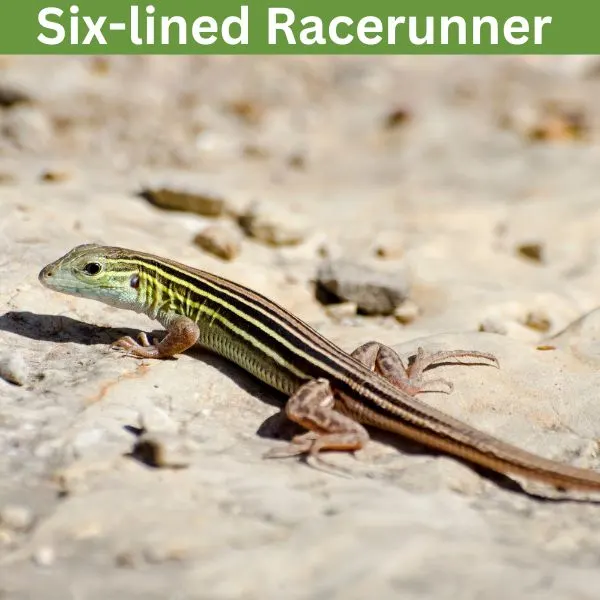In Illinois there are 8 lizard species that live in the state. Other reptiles that live in Illinois include snakes, and turtles, but lizards are among the most commonly seen. Lizards are found throughout the year, and if you know where, and when they are active it can make finding them in the wild much easier.
This article will not only go over the 8 lizards that live in Illinois, but also other useful things about them. Lizards are identified by their colors, pattern on them, behavior, habitat, and other small details like their scale orientation. Let’s take a look at all the lizards you may find in the Prairie State Illinois, and some of the interesting things about them.
Table of Contents
Lizards in Illinois
1. Slender Glass Lizards

- Experience Level: Intermediate
- Family: Anguidae
- Scientific Name: Ophisaurus attenuatus
- Other Names: n/a
- Adult Size: 22 to 46 in. (55.88 to 116.84 cm.)
- Lifespan: 10 to 30 years
- Average Price Range: $50
Slender glass lizards are a rare, and threatened lizard that lives in Illinois. Prairies, old fields, and open woodlands are the habitats these lizards live in. They are a burrowing lizard, and will use their holes to sleep, or hibernate.
The bodies of the slender glass lizard are long and legless, similar to a snake. This species has an olive, or tan coloring, with dark lines that run down their sides. They have a speckled pattern on their sides, and smooth scales. This lizard is able to be identified from snakes from their blinkable eyes, and ear holes.
Slender glass lizards are not harmful to humans. We have caused the population of this lizard to decline due to habitat fragmentation, and pollution. Unlike snakes, these lizards are only able to feed on smaller prey, and cannot hyper-extend their jaws. Originally these lizards were thought to be fragile like glass, since their tail would shatter if stressed.
2. Eastern Fence Lizard

- Experience Level: Intermediate
- Family: Phrynosomatidae
- Scientific Name: Sceloporus undulatus
- Other Names: Northern fence lizard, gravid lizard, pine lizard
- Adult Size: 4 to 6 inches
- Lifespan: 5 to 7 years
- Average Price Range: $20
In Illinois the eastern fence lizard lives in the far southern portion of the state. Rocky woodlands, and hillsides are the habitats these lizards live in. Often found in urban areas, eastern fence lizards may sometimes be seen on fences, or large rocks. Eastern fence lizards are active in the day, with peak activity from spring to fall.
Eastern fence lizards have a coloring that ranges from tan to gray. Females may sometimes have a wavy pattern on their back, while males are more plain. These lizards have small bodies, with roughly keeled scales.
The mating season is when these lizards may lay between 3 to 16 eggs. Their mating season lasts until fall, and brumation occurs in the winter until spring. Eastern fence lizards spend their day feeding on insects, spiders, and other invertebrates.
3. Little Brown Skink

- Experience Level: Beginner
- Family: Scincidae
- Scientific Name: Scincella lateralis
- Other Names: Ground Skink, Brown-backed Skink
- Adult Size: 3 to 5.25 in. (7.62 to 13.3 cm.)
- Lifespan: 2.5 years
- Average Price Range: $5
In Illinois the little brown skink is mainly found near the southern tip of the state, but has a range scattered in other southern regions of the area. Little brown skinks are one of the smallest lizards that live in North America. Found in moist soil, and leaf litter, little brown skinks live in woodlands, and urban environments.
Bodies of this lizard are slender, and their limbs are very small. As their name suggests these lizards have a brown coloring, with a dark stripe on their sides, and specks on them. The scales of this lizard are small, and smooth.
In the spring and summer these small lizards mate. They lay around 2 to 7 eggs, placing them in moist soil. Their eggs incubate for around 22 days, until they hatch. These lizards have very short lifespands, and reach maturity within a year.
Little brown skinks stay in the ground, or soil to hide from predators like larger lizards, shrews, and hawks. These skinks drop their tail, or use camouflage to hide. Small insects, and isopods are what this species eats.
4. Common Five-lined Skink

- Experience Level: Intermediate
- Family: Scincidae
- Scientific Name: Plestiodon fasciatus
- Other Names: American
- Adult Size: 4.9 to 8.5 in. (12.5 to 21.5 cm)
- Lifespan: 6 years
- Average Price Range: $12
Common five-lined skinks live in the southern half of Illinois. In gardens, farms, woodlands, swamps, urban areas and grasslands are some of the places this lizard is found. Active in the day, when not seen you may sometimes find this lizard under rocks, logs, or other debris.
These lizards get their name from the five lines that run down their body from their head to their tail. Tan, olive, or black are the colors these lizards appear in, and small, smooth scales cover them. Their slender bodies are supported by small limbs, and they have a flat appearance.
Common five-lined skinks are one of the most common lizards in the eastern United States, and have a stable population. The breeding season from May to July is when these lizards mate. Their eggs are laid in rotting stumps, burrows, logs, or other similar habitats.
Spiders, crickets, geetles, and other bugs make up the majority of this species’ diets. Larger lizards may feed on mice, frogs, or other small animals. Common five-lined skinks have a blue tail when young like other skinks, and drop their tail if attacked.
5. Broad-headed Skink

- Experience Level: Intermediate
- Family: Scincidae
- Scientific Name: Plestiodon laticeps
- Other Names: Broadhead Skink, Red-headed Scorpion
- Adult Size: 5.9 to 13 in. (15 to 33 cm.)
- Lifespan: 4 to 8 years
- Average Price Range: n/a
The broad-headed skink is one of the largest lizards that live in Illinois. This species is found across the eastern United States. In Illinois this lizard is found in most of the southern half of the state. Woodlands, and grasslands near water sources are common places this lizard lives. They are semi-arboreal, often found on trees, fences, or other structures.
The large head, and size of this skink is their most identifying trait. Males of this species have large heads, which sometimes have red colorings. Their bodies have tan, olive, or gray, with smooth scales. These lizards can have stripes that run down their body, or a plain appearance.
Broad-headed skinks breed in the spring and summer, laying up to 22 eggs. They place their eggs in moist environments, like in soil, or dense vegetation. These skinks are very skittish, and will flee if spotted. Not only are these lizards common, but they also are important in feeding on pest insects, and other invertebrates near them.
6. Six-lined Racerunner

- Experience Level: Intermediate
- Family: Teiidae
- Scientific Name: Aspidoscelis sexlineata
- Other Names: Sandlapper lizard
- Adult Size: 6 to 9.5 in. (15 to 24 cm.)
- Lifespan: 4 to 5 years
- Average Price Range: $30
Six-lined racerunners are found in the eastern United States, and can be sighted in the majority of Illinois. These lizards live in mountains, woodlands, grasslands, and urban areas. Six-lined racerunners get their name from the six lines that run down their back. They have a tan, black, or olive appearance with yellow stripes on them.
These lizards feed on insects, spiders, and other small invertebrates. They are active in the day, but use burrows to hibernate. Six-lined racerunners are very heat tolerant, and are one of the few lizards active in the hottest time of the day.
Six-lined racerunners are capable of laying up to 6 eggs in their breeding season. They may lose numbers in their population due to roads, and other fragmentations of their habitat. These lizards are common, and have a stable population.
7. Eastern Collared Lizard

- Experience Level: Intermediate
- Family: Crotaphytidae
- Scientific Name: Crotaphytus collaris
- Other Names: Yellow-headed Collared Lizard
- Adult Size: 8 to 15 in. (20 to 38 cm.)
- Lifespan: 10 to 12 years
- Average Price Range: $70
In Illinois the eastern collared lizards are mainly found in the southern portion of the state. These lizards get their name from the collar marking that appears around their neck. Eastern collared lizards are sexually dimorphic, with males being much more colorful.
The males of this species have a blue, or yellow coloring, while females are more gray, or brown. Spots, bands, and bars are the types of marks that appear on them. These lizards are medium sized, with large heads. When running they reach speeds up to 21.5 mph (34.6 km h), and when moving may run bipedally.
Insects, and small vertebrates are what these carnivorous lizards eat. Eastern collared lizards will eat more in the breeding season. They are active in the day, and spend their time basking in the sun on rocks, or hunting.
8. Mediterranean House Gecko

- Experience Level: Beginners
- Family: Gekkonidae
- Scientific Name: Hemidactylus turcicus
- Other Names: Moon Lizard, Turkish Gecko
- Adult Size: 4 to 5 in. (10 to 13 cm.)
- Lifespan: 3 to 9 years
- Average Price Range: $10
Mediterranean house geckos are native to the Mediterranean region, but have managed to build a population within the southern portion of Illinois. These lizards are a very invasive species, found in North America, and places around the world. Urban habitats near homes, and warehouses are common areas this lizard lives in.
Small in size, this lizard has very large yellow eyes, with elliptical pupils. Their skin is very bumpy, and they have a tan, or cream coloring. Dark blotches of brown and back also cover their body.
The adaptability, and quick breeding cycle of this lizard is why they have managed to become invasive in several regions around the world. Click sounds are used to attract a mate, and they breed from spring to fall.
Night is when these geckos are active, and they are typically found in or around buildings. Small in size and mainly found in urban areas, this gecko does not have a major impact on the Illinois environment.
FAQ
How many lizards live in Illinois?
In Illinois there are eight lizard species that are found in the state, with two of them being from other regions in the world. The pet trade, and global shipments from other countries are the main causes for lizards to be transported to new areas, where they can possibly build a population.
Are there any dangerous lizards in Illinois?
In Illinois there are no venomous, or poisonous lizard species within the state. Lizards are harmless to humans, but if cornered or provoked they may bite. Germs are the biggest threat that lizards have, and they can spread disease like salmonella.
In Illinois what is the largest lizard species?
Broad-headed skinks are the largest lizard species in Illinois, and are also one of the largest skinks across their habitats. These lizards have a length between 6 to 13 in. (15 to 33 cm). Despite their size and bright colors this species is harmless to humans.
Wrapping up
Lizards are very common reptiles to come across in Illinois, and they can be found in the far wilderness, or near homes next to people. Some lizards are very common, while others are more rare. Learning about the lizards near you is important in protecting, and maintaining populations in a region.
Some of the lizards in Illinois make good pets, but you should always do deep research on an animal before getting one. One common reason lizards become invasive is since they are a former pet released into the wild. Not only are lizards a part of the amazing ecosystem of Illinois, but they are also fun animals to learn about.
More lizards in nearby states
